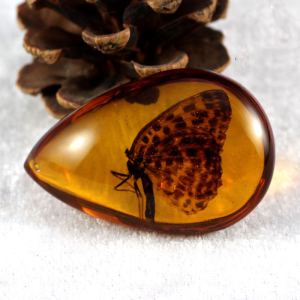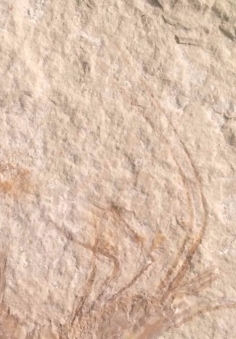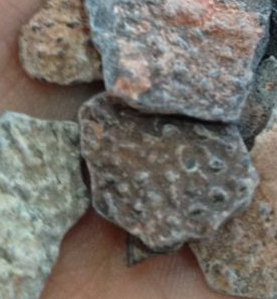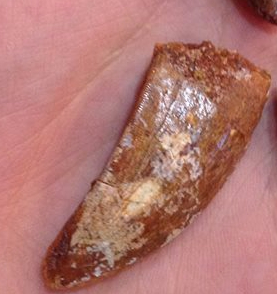Fake fossils can be found from pretty much any regions, but there are certain sites and taxons where it is more likely. There are often features in fake fossils to give them away, and this guide will cover several of the major tells.
One important note is that fossil fabricators are always evolving, particularly for high-end specimens, so always be vigilant! Make sure to only purchase from trusted dealers who know the history behind their pieces, and are familiar with the science of paleontology. Many of the giveaways for fake fossils will be masked with expensive, rare specimens, and if you are ever in doubt, err on the side of caution.
This guide will be broken up to vertebrates and invertebrates, and will have example pictures of fake and real fossils owned by Reese’s Rocks, with other images provided with sources.
INVERTEBRATES
The most commonly faked invertebrates are trilobites; however, other fossils such as crinoids can also be faked. For certain formations or species, restoration is often the norm when it comes to trilobites; for example, Ordovician trilobites from St. Petersburg, Russia (including the iconic Asaphus kowalewski and Hoplolichas furcifer) almost always have restoration because of how they are typically preserved. The ‘acceptable’ amount of restoration is subjective: for a common species like Asaphus punctatus, restoration generally doesn’t exceed 10%, but for a rare species like Valdaites limatus, this might be 20%. Russian Lichids are infamous for the restoration, oftentimes missing key morphological features. Conversely, sites like the Utahn Wheeler Shale produce trilobites where restoration is atypical, and almost exclusively done to large, near-complete pieces like Asaphiscus wheeleri. Regardless of how common restoration is, dealers should always be upfront about it, as this influences the price and desirability to certain collectors.
One of the ways to identify restoration is by using blacklights. Oftentimes, the repair will fluoresce against the authentic trilobite and matrix, showing how much restoration was done; you can also use dilute rubbing alcohol or acetone to uncover paint, but exercise causing to not damage a suspect piece in case it’s authentic.
Morocco is notorious for producing fake fossils ranging from placoderms to starfish to, of course, trilobites. Some collectors shy away from all Moroccan fossils because of the risk; however, this excludes a wealth of fantastic, and oftentimes affordable, fossils from all over the country. For fake trilobites from Morocco, this guide will break them up temporally. Many of the features of these trilobites will be valuable in spotting fake specimens from other localities, although it’s important to remind prospective buyers that the quality of fake fossils tends to increase with the price, so the features discussed here are unlikely to be diagnostic of pricy trilobites.
CAMBRIAN
Perhaps the most famous fake trilobite in the world is Cambropallas telesto, a supersized Cambrian bug with a distinctive shape recognizable from roadside rock shops. Complete Cambropallas are fairly rare, and large ones can get very expensive – which leads to the market for fakes. Paradoxides specimens are almost guaranteed to be fake due to a paucity of authentic specimens, but because of this they are somewhat less common on the market than fabricated Cambropallas.

Fake Cambropallas trilobite. Look at the genal spines and upper thorax, which are different colors than the rest of the specimen, along with grainy textures and inconsistent morphology. The darker brown parts are original, though likely unassociated, while the orange sections are fake.
Morphology, the shape of the exoskeleton (including features such as eye lenses, spine placement, etc.) is one of the first things to look for an a fake trilobite. Oftentimes with Cambropallas, the morphology of fake specimens differs significantly from authentic ones. Another thing to take note of is color variation, although this does not extend to all trilobites (for example, partially pyritized trilobites from the Windom Shale in New York are fairly common). In the case of Cambropallas, color variation is often the result of taking very incomplete specimens and reconstructing the trilobite around it; however, restoration is a generous term to apply here, as the case may be 20% real fossil and 80% fake. Another tell of a fake, or restored, fossil is unreasonable preparation marking. Trilobites do have preparation marks around them unless an air eraser has been used to smooth the matrix, but these preparation marks should be logical relative to the specimen. Haphazard scratching is often used to hide seams where a fake fossil has been inset into a matrix.
One takeaway is that big trilobites should always be treated with skepticism, regardless of origin. American Arctinurus and Isotelus are quite often repaired, and dealers may be hesitant to provide this information lest it jeopardize a sale; while near-mythical trilobites like Moroccan Burmeisteria are both expensive and composited (or faked). If you are spending hundreds or thousands on a trilobite, make sure to do your research on the species’ morphology and rarity. A caveat to this is pathological specimens, which can exhibit atypical morphology, although these are quite rare and expensive.
ORDOVICIAN
Ordovician trilobites from Morocco have only recently been popping up commercially, although many of the features discussed for Cambrian trilobites will be true here as well. These trilobites tend to be smaller, but restoration and especially staining are not uncommon.

Asaphid trilobite that has been stained. Note how the color bleeds over the edge, as well as the color variation on the pygidium. The matrix on this piece has also been reconstructed, which can be seen on the righthand side.
Be sure to ask questions about a piece that you are interested in. However, fewer Ordovician trilobites are faked because the market tends to be more savvy, and there is less money in it than in Cambrian and Devonian trilobites. But don’t assume that uncommon means none–fake American trilobites are not unheard of!
The major exception to that are Flexicalymene trilobites from Alnif, Morocco. These trilobites are ubiquitous commercially, and are never entirely faked; however, they are frequently found as partials, are are composited together to create one complete trilobite.

Partial trilobites like these are joined to create composite specimens.
DEVONIAN
Moroccan Devonian trilobites are some of the most well-known in the world, and have a much bigger list of fakes trailing behind. Fortunately, the majority of commercially available fakes can be easily identified, but when dealing with rare and expensive species, exercise caution and only buy from trusted sellers.
In addition to the morphology discussed above, Devonian fake trilobites often have poorly imitated eyes. Phacopids have schizochroal lenses, which should be seen in line with the quality of the rest of the piece; a poorly prepared specimen logically has poorly prepared eyes, but the individual lenses should still be present.

Very poorly prepared Metacanthina with non-present eye lenses, an incorrect number of pleura, and missing genal spines. This specimen has restoration to the cephalon and thorax, but is actually partially original – although certainly not something worthy of top-shelf display.
As with Cambrian trilobites, extra suspicion should be applied to large trilobites.

This fake Phacopid trilobite has a partially authentic thorax, but exhibits many of the tell-tale signs of a replica. The lack of definition is suspect, and the lack of eye facets is a major red flag. The differing textures and incorrect morphology show are additional features showing this is a fake trilobite. Lastly, the preparation marks are illogical for the piece, which were used to obscure where the fake trilobite was bonded with the specimen.
One of the ways to test for plastic imitators, which can often be higher quality than other casts (occasionally given away by air bubbles in the body of the specimen), is to place your front teeth against the specimen. Authentic trilobites should be hard, while fakes may have more give.
Genera that are commonly faked are Odontochile, Zilchovaspis, Hollardops, Metacanthina, Cyphaspis, Drotops, Dicranurus, and Quadrops. The quality of most common fake trilobites is quite poor, but spiny, highly sought over trilobites like Konupresia often start with a real ‘base’ (though this can be from a different species) but the delicate spines are entirely fabricated.

Cyphaspis sp. with fake spines. See how they don’t match accurate morphology, and are a darker color than the rest of the specimen. Spines, as they taper off, tend to turn lighter, one of the signs of an authentic trilobite. Also note the matrix color, which changes about halfway up the left side; the matrix is composited for display. The cephalon, thorax, and pygidium are all partially real, but this trilobite has quite a bit of restoration work done to it.

A classic, but entirely fake, Dicranurus monstrosus. In addition to the lack of detail, the desirable ‘horns’ have not been prepared (because they are not real), which would be extremely atypical for an authentic specimen. Additionally, the significant amount of illogical preparation marks hide that this is simply a cast. Image credit.
The specimens above show that there is quite a range in the quality of fakes, with some well-done copies almost indistinguishable from a real specimen. Fortunately, the majority of specimens that casual collectors are interested in are covered by the features above.
INSECTS
The most common fake insect fossils are undoubtedly amber and copal. There are several methods to fake these fossils, but the most common one we see is where copal, or immature amber, is being sold as true amber; because copal is much more common than true amber, it is less valuable. Copal will give off an aromatic scent when rubbed with a soft cloth, and will feel waxy or sticky to the touch; amber will not soften. Some websites recommend poking a suspect piece with a hot needle, but this risks damaging authentic amber anyway, which is still quite fragile.
For entirely fake amber, the most common method is plastic simply encasing modern insects. If you are looking at piece, verify that the taxon in question actually existed at the time. An unorthodox but effective method for ruling out plastics is to wash the suspect piece carefully with water and soap, which does not damage true pieces, then taste them. Amber and copal should be smooth and relatively tasteless, but plastic will taste quite bitter. We have tried this to great success, and recommend it because it is not damaging to the pieces. We first read about this method from Gary Platt here.

Fake plastic amber. Note that this piece is being sold as a plastic replica, which is a refreshing change of pace. Image credit.
An uncommon, but harder to catch, method of faking involves taking authentic amber, drilling into it, then inserting a modern insect and refilling the hole with plastic, copal, or amber. We have not seen these pieces in person, but referring to known taxa (as with plastic pieces) and enquiring about the provenance of expensive specimens should help avoid these pieces.
One last method of amber fabrication is reconstituting amber, which is to take small, unassociated pieces and melt them together. This is primarily done for jewellery, but can be easily identified by the number of reflective flakes inside the piece.

Reconstituted amber orb being sold with accurate labelling. Image source.
Other fake insects are primarily going to be painted, with staining the most common form of restoration. Be sure to carefully inspect the morphology of pieces you are looking at, and see the picture below of a stained crustacean to see how to identify altered insects. Some insects can be entirely painted, though the lack of fine detail makes identifying these easier.
CRUSTACEANS
Crustaceans are less popular than trilobites, but are still a large enough part of commercial sales – oftentimes to casual collectors for decoration – that fakes exist. For most crustaceans, staining or painting is the extent of alteration to pieces. One example can be seen in Carpopenaeus callirostris, a Lebanese Cretaceous shrimp, which is quite commonly stained; this can be seen by looking at the elevation of features like legs, which should lay on one plane and be quite detailed. However, three-dimensional or freestanding crustaceans are more susceptible to complete forgery. This can be done by using modern shells, so be sure to research the literature on a piece you are looking at to see if such a fossil does exist.

Stained Carpopenaeus callirostris shrimp. Look at the color variation on the base on the antennae.
For some crustaceans that are displayed in impressive poses, restoration is the standard. Be sure to ask the seller about what has been done, but don’t be upset by reasonable amounts. Pulalius vulgaris, a classic crab fossil found in concretions, is very tedious to prepare, and it may not be obvious how complete a specimen is when starting. If a specimen is missing legs, they are often carved into the matrix for display, but this does not make the entire fossil fake. It is up to you to determine what’s appropriate for restoration.
 Incomplete Pulalius vulgaris fossil. Because of its size it was not repaired, although legs could be carved in to imitate a complete exoskeleton. Image source.
Incomplete Pulalius vulgaris fossil. Because of its size it was not repaired, although legs could be carved in to imitate a complete exoskeleton. Image source.
OTHER
Many other fake invertebrates can be found, although many of the features discussed above will help identify them. As with the Lebanese shrimp, two dimensional fossils should be examined to see if the color matches the plane; don’t hesitate to ask questions, and hold off an purchasing something if you are suspicious of it.

Stained Knightia alta from the Green River Formation. Note how the caudal fin entirely misses the actual fossil.
VERTEBRATES
Fake vertebrate fossils are quite a bit different than invertebrates, and oftentimes harder to identify even standard fakes. Nonetheless, there are certain features to look for, and certain specimens to be skeptical about, that should help you when hunting for the perfect piece.
The first rule for vertebrates is always be skeptical. You should be aware about fake trilobites or crinoids when shopping around, for example, but when looking at vertebrates, our assumption is always guilty until proven innocent because of the extraordinary amount of fakes, composites, and heavily restored specimens. Particular specimens are even more likely than average to be faked; for example, dinosaur claws and eggs, articulated skeletons, Pleistocene skulls, and early Hominid fossils are, nine times out of ten, fake.
This section will outline major features of fake vertebrate fossils, but for all pieces – and particular those listed above – exercise extreme caution with a dose of common sense. Dinosaur claws are rare and extremely desirable, so they tend to be quite expensive and oftentimes circulate to high-end dealers – so they never show up at flea markets for $20.
For two dimensional fossils, the features described above are good starting points for fake fossils. Keichousaurus is a pachypleurosaur from China that is particularly commonly faked, often using resin; be sure to ask for the provenance on specimens. One method that we have found useful is carefully scraping the matrix, preferably with preparation tools, around the vertebrae of a specimen to see if the bone continues into the matrix. Most Keichousaurus specimens are poorly prepared, so that is not a good marker for authenticity.

Entirely carved Keichousaurus hui. Note the definition of the bones, particularly the vertebrae and digits. The white crack is likely plaster imitating authentic calcite veins. Image source. This piece was being sold as a replica, fortunately.
Dinosaur eggs are another frequently faked fossil due to their desirability, but in general they are somewhat easy to catch because of mismatched textures in composites as well as entire fabrications.
Replica Oviraptor nest. Look at the textures of the eggs themselves; this piece is being sold as a replica. Image source.

Authentic eggshell fragments like these can be used to construct composite eggs, though the textures – and price – should make prospective buyers suspicious.
One of the major problems of Dinosaurian fossils, in addition to fakery, is misidentification. A Carcharodontosaur tooth can easily become a Tyrannosaurus tooth to a novice seller and a trigger-happy buyer, so make sure you know what you are buying before you do.

An authentic Carcharodontosaur tooth. It’s worth acknowledging that these are often sold as ‘African T-rex teeth’, though the two species are not closely related.
The last section to cover for vertebrates, although certainly not exhaustive, is composited specimens. Mosasaurus, a marine reptile, is a popular taxon commercially, and teeth are quite common in northern Morocco. Articulated jaws, however, are rare and as a result quite expensive. A fantasy construction of a mosasaur jaw is a common item to be found, but they are occasionally labelled as authentic.


This composite jaw was easy to break apart, and constructed of authentic teeth, modern animal bone, Cretaceous bone fragments, and plaster.
Although they don’t look convincing, to novice buyers it may seem like they are snagging a deal.
This guide does not cover all possible fake fossils and species to look out for, but is hopefully a good introduction to identifying fake fossils on your own. Have fun collecting, and be careful!
Reese’s Rocks

